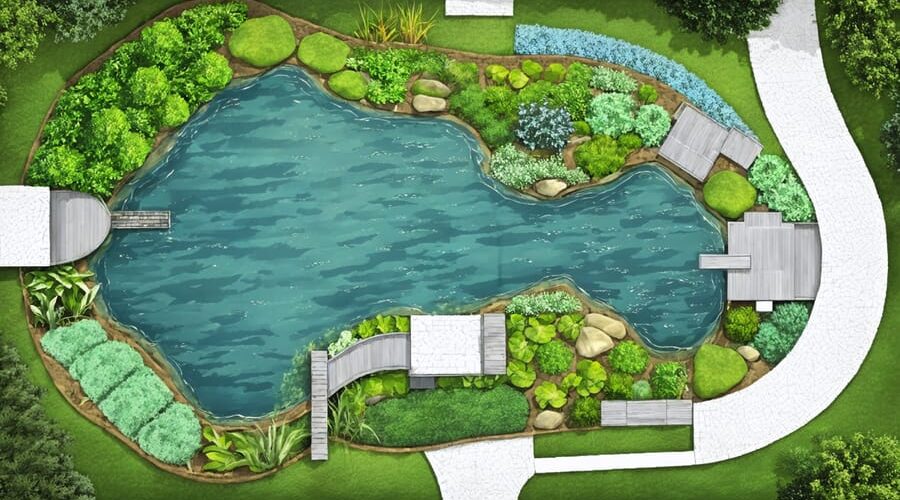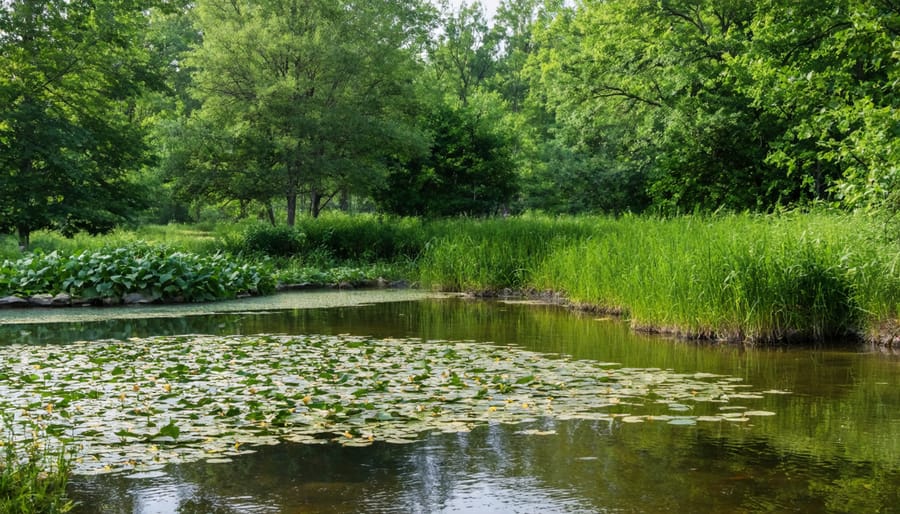
BMP Ponds: Your Natural Solution for Protecting Local Water Quality
BMP ponds, or Best Management Practice ponds, represent a crucial innovation in sustainable water management, combining natural water filtration with flood control capabilities. These engineered basins serve as both functional stormwater management systems and attractive landscape features, capturing runoff from surrounding areas while removing pollutants through natural processes. For homeowners and property managers, BMP ponds offer an elegant solution to water quality challenges while creating valuable wildlife habitat and enhancing property aesthetics.
Unlike traditional drainage systems, BMP ponds work with nature rather than against it, utilizing vegetation, soil, and gravity to clean and manage water flow. These systems can reduce flooding risks, improve groundwater recharge, and protect local waterways from contamination – all while providing a beautiful, low-maintenance water feature that increases property value. Whether you’re planning a new development or looking to upgrade existing drainage solutions, understanding BMP pond design and maintenance is essential for creating sustainable, environmentally-friendly water management systems.
What Makes a Pond a BMP Pond?
Key Design Features
A BMP pond’s design revolves around several key features that work together to manage stormwater effectively. The main basin, carefully shaped to hold water, includes both permanent and temporary storage areas. A forebay, located at the pond’s inlet, acts as a preliminary settling zone for sediment and debris. The pond’s banks are gently sloped and typically reinforced with vegetation to prevent erosion.
The outlet structure is particularly important, usually featuring a primary spillway for normal water flow and an emergency spillway for overflow during heavy storms. Most BMP ponds incorporate aquatic benches – shallow areas around the perimeter that support wetland plants and help filter pollutants. The bottom of the pond is often lined with clay or synthetic materials to prevent water seepage.
Access points for maintenance vehicles and safety features like gradual slopes and warning signs are also essential components of well-designed BMP ponds.

Water Quality Benefits
BMP ponds play a crucial role in protecting our water resources by acting as natural water filtration systems. These ponds work by capturing and treating stormwater runoff before it reaches our streams and rivers. As water flows into the pond, it slows down, allowing suspended particles like sediment, debris, and pollutants to settle at the bottom. This process, known as sedimentation, helps remove up to 80% of harmful substances from the water.
The pond’s aquatic plants and beneficial bacteria work together to break down nutrients and filter out chemicals, much like nature’s own purification system. They’re particularly effective at removing common pollutants like nitrogen, phosphorus, and heavy metals that can harm aquatic life. The clean water that eventually leaves the pond is much safer for our environment and local wildlife, making BMP ponds an essential tool in protecting our water resources and maintaining healthy ecosystems in our communities.
Creating Your BMP Pond
Site Selection and Planning
When planning your BMP pond, location is crucial for both effectiveness and environmental impact. Start by conducting a thorough site assessment, looking for natural low points where water naturally collects. These areas often make ideal locations for your pond, as they’ll work with the existing drainage patterns.
Consider the surrounding landscape and ensure your chosen spot is at least 10 feet away from building foundations and property lines. The area should have enough space not just for the pond itself, but also for maintenance access and potential future expansion.
Soil type plays a vital role – conduct a simple percolation test by digging a small hole and filling it with water. If it drains too quickly, you might need additional liner materials. If it drains too slowly, you may need to incorporate better drainage solutions.
Pay attention to existing utilities and underground services. Always call your local utility companies before digging to mark any buried lines. Also, check local regulations and permits required for pond construction, as requirements vary by location.
Finally, consider the pond’s visibility and how it will integrate with your landscape design. A well-placed BMP pond can become an attractive focal point while serving its practical purpose.

Essential Components
A well-designed BMP pond requires several key components to effectively manage stormwater and protect water quality. The first essential element is a properly sized inlet structure that allows water to flow into the pond during rainfall events. This inlet should include a debris screen to prevent large objects from entering the system.
The main pool, or permanent pool, is the heart of the pond system. This area maintains a constant water level and provides the primary treatment zone where sediments and pollutants settle out. The pool should be deep enough (typically 4-8 feet) to prevent vegetation from taking over and maintain adequate water volume.
A forebay, located near the inlet, acts as a preliminary settling basin. This component captures coarse sediments before they enter the main pool, making maintenance easier and extending the pond’s lifespan. The forebay should be easily accessible for regular cleaning.
The outlet structure controls water release and maintains the desired water level. It typically includes a principal spillway for normal flow and an emergency spillway for extreme weather events. Both must be properly sized to handle expected water volumes.
Aquatic benches, or shallow shelves around the pond’s perimeter, support vegetation that helps filter pollutants and provide wildlife habitat. These areas should be 10-15 feet wide and planted with native species.
Maintenance access is another crucial component. A stabilized path or road should allow equipment to reach key areas for regular upkeep. Finally, safety features like gentle slopes and warning signs help protect both wildlife and people who might visit the pond.
Maintaining Your BMP Pond
Seasonal Maintenance Tasks
Maintaining your BMP pond requires different tasks throughout the year to ensure it functions effectively and remains environmentally friendly. Following sustainable maintenance practices will help you keep your pond healthy while minimizing costs and effort.
In spring, focus on removing winter debris, checking for damage, and trimming back any overgrown vegetation. Test water quality and ensure filtration systems are working properly after winter dormancy. Summer maintenance includes regular algae monitoring, maintaining proper water levels, and managing aquatic plant growth.
Fall brings the important task of removing fallen leaves before they sink and decay. Install pond netting to catch debris and trim back dying plant material. In winter, keep a small area free from ice if you live in a cold climate, and reduce feeding if you have fish.
Monthly tasks include checking water quality, clearing debris from filters, and ensuring all mechanical components are functioning correctly. Remember to document any changes or issues you notice, as this helps track your pond’s health over time.
Common Issues and Solutions
Even well-maintained BMP ponds can face several common challenges. Algae overgrowth is perhaps the most frequent issue, especially during warm months. To combat this, consider adding aquatic plants that compete with algae for nutrients or installing aerators to improve water circulation.
Erosion around the pond edges can compromise its effectiveness. Address this by reinforcing banks with native vegetation or installing erosion control materials. If you notice water levels dropping unusually fast, check for possible leaks in the liner or damaged outlet structures.
Sediment buildup is another typical problem that reduces pond capacity over time. Regular maintenance should include removing accumulated debris and scheduling periodic dredging when necessary. Unpleasant odors might develop due to poor circulation or excess organic matter – installing additional aerators or removing dead vegetation can help resolve this.
During heavy rainfall, overflow issues may occur. Ensure emergency spillways are clear and functioning properly. If your pond frequently overflows, you might need to reassess its capacity or improve drainage systems upstream.
Enhancing Your BMP Pond’s Beauty

Plant Selection
Choosing the right plants for your BMP pond is crucial for both functionality and aesthetics. Native aquatic plants are your best choice, as they’re already adapted to your local climate and provide natural filtration. Consider including emergent plants like cattails and rushes along the pond edges to help prevent erosion and filter runoff. Floating plants such as water lilies and duckweed help shade the water and reduce algae growth, while submerged plants like hornwort and water milfoil provide oxygen and habitat for beneficial organisms.
For the best results, aim for a mix of different plant types, placing them at various depths. Start with about 50-60% plant coverage of your pond’s surface area. Remember to avoid invasive species that might take over your pond or spread to nearby water bodies. Your local extension office can recommend specific plants that work well in your area and comply with regional regulations.
Landscaping Tips
To make your BMP pond a stunning landscape feature, consider creating a natural-looking buffer zone with native plants and grasses. This not only enhances aesthetics but also helps filter runoff. Layer plants of varying heights, starting with shorter ground covers near the water’s edge and gradually increasing to taller shrubs and ornamental grasses further back.
Add stepping stones or a gravel path around the pond for easy maintenance access while creating visual interest. Consider incorporating rock gardens or boulder clusters to prevent erosion and add natural appeal. Native wildflowers not only attract beneficial insects and birds but also require minimal maintenance.
For year-round appeal, mix evergreen and deciduous plants. Consider adding aquatic plants like water lilies or rushes within the pond itself. Remember to maintain clear sight lines from common viewing areas like patios or windows. Solar-powered landscape lighting can create beautiful evening reflections while highlighting your pond’s best features.
Include seating areas where you can enjoy the peaceful water views and wildlife that your BMP pond attracts.
BMP ponds represent a perfect blend of environmental responsibility and practical water management for homeowners and communities alike. These essential features not only help control stormwater runoff and prevent flooding but also create beautiful, natural spaces that enhance property value and support local wildlife. By incorporating native plants and proper design elements, BMP ponds effectively filter pollutants, reduce erosion, and replenish groundwater supplies.
The benefits extend beyond environmental impact – these ponds can become focal points for outdoor recreation, education, and community gatherings. Whether you’re a homeowner looking to manage water on your property or part of a larger development project, BMP ponds offer a sustainable solution that works with nature rather than against it.
Remember that successful BMP pond implementation requires proper planning, regular maintenance, and a commitment to environmental stewardship. With the right approach, these water features can provide years of service while contributing to a healthier, more sustainable environment for future generations. The investment in a BMP pond today means cleaner water, better flood control, and a more beautiful landscape tomorrow.
